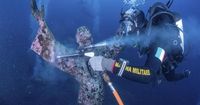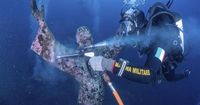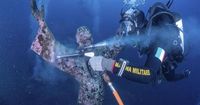Just off the rugged northern coast of Italy, beneath the shimmering surface of the Ligurian Sea, a remarkable bronze figure stands sentinel. The "Christ of the Abyss"—a 2.5-yard-tall statue of Christ with arms outstretched in blessing—has long been a cherished symbol for locals and a magnet for divers, kayakers, and paddleboarders from around the world. On August 19, 2025, police divers once again donned their wetsuits for the annual ritual of cleaning this underwater treasure, a process as fascinating as the statue itself.
The statue, nestled about 300 yards off the beach between the picturesque resort towns of Portofino and Camogli, was placed on the seabed in 1954. Its origins are steeped in solemnity and sacrifice. According to the Associated Press, the bronze was cast from melted-down medals belonging to Italy’s fallen soldiers, as well as cannons and ships—a poignant tribute to those lost at sea and a potent symbol of World War II’s enduring legacy. Italian artist Guido Galletti created the work to honor a diver who died in the area, infusing the sculpture with both personal and national significance.
Over the decades, the "Christ of the Abyss" has become the most frequented dive spot in the Mediterranean, as noted by Italy’s Culture Ministry. Its popularity owes much to its accessibility: the statue rests at a depth of about 18 yards, making it visible not just to scuba enthusiasts but also to those gliding above on kayaks and paddleboards. The site’s location in the bay of San Fruttuoso adds to its allure, drawing visitors eager to glimpse the outstretched arms of Christ rising from the sea floor, even from the surface.
But the underwater environment is not kind to bronze. Each year, the statue accumulates a thick layer of crustaceans, bacteria, and other marine organisms. To preserve the monument’s dignity and prevent further corrosion, police divers employ a specialized cleaning technique: water-blasting with pressurized hoses. This method, which has been standard practice since 2004, uses seawater itself to gently remove the accumulated growth. Alessandra Cabella, an art historian with the Ligurian archaeology superintendent’s office, explained in an interview with the Los Angeles Times, "There are a ton of marvelous fish who come to watch. It’s truly an activity with zero impact on the environment."
The cleaning process is a spectacle in itself. Divers, equipped with hoses, carefully direct jets of seawater at the statue, dislodging microorganisms and releasing them harmlessly back into the sea. This approach is a far cry from the previous method—scraping the bronze with metal brushes—which, as restorers discovered during a major restoration in 2004, caused irreparable damage. The metal brushes created tiny crevices in the statue’s patina, making it even more susceptible to future marine buildup. The shift to water-blasting was both a scientific and environmental leap forward, ensuring the longevity of the statue without harming the surrounding ecosystem.
The 2004 restoration was prompted by a significant event: one of the statue’s hands had broken off and needed to be reattached. When conservators hauled the statue out of the water for repairs, they were alarmed to find the surface pitted and scarred from years of abrasive cleaning. That discovery led to a reassessment of conservation techniques, culminating in the adoption of the current, gentler method. Since then, the annual cleaning has become a carefully choreographed operation, balancing the needs of heritage preservation with environmental stewardship.
Yet, the statue faces another, more insidious threat from within. When Galletti crafted the "Christ of the Abyss," he filled the hollow bronze form with cement and iron rods to ensure it would remain stable on the seabed. Over time, however, the iron has begun to corrode, eating away at the bronze from the inside. Cabella cautioned that this internal decay makes the statue particularly delicate, requiring ongoing vigilance and care. "The presence of the iron has helped corrode the bronze from the inside," she noted, underscoring the complex challenges of underwater conservation.
The statue’s story doesn’t end in Italy. Its iconic pose and symbolic resonance have inspired similar monuments in other parts of the world, most notably off the coast of Key Largo, Florida, and in Grenada. These replicas serve as both tributes and reminders of the original’s enduring message of peace, sacrifice, and remembrance.
For those who visit the bay of San Fruttuoso, the experience is unforgettable. Divers descend through clear blue waters to find themselves face-to-face with the serene figure, his hands raised in a gesture of blessing. Above, sunlight filters down, illuminating the bronze and casting rippling shadows across the seabed. For kayakers and paddleboarders, the statue is a mysterious shape glimpsed through the water, a hidden treasure just out of reach. The site’s accessibility and beauty have made it a beloved destination, and the annual cleaning ensures that it remains so for generations to come.
The environmental impact of the cleaning operation has been a topic of particular pride for those involved. By using seawater instead of chemicals or abrasive tools, the divers minimize harm to both the statue and the surrounding marine life. The microorganisms removed from the bronze are simply returned to their natural habitat, maintaining the delicate balance of the underwater ecosystem. As Cabella put it, "It’s truly an activity with zero impact on the environment." Her words echo the broader ethos of modern conservation: preserving cultural heritage without compromising the health of the planet.
The "Christ of the Abyss" stands as more than just a work of art. It is a memorial, a symbol, and a living testament to the power of remembrance. Its story—of sacrifice, loss, and renewal—resonates not only with Italians but with all who venture beneath the waves to witness its silent benediction. As each year passes and the divers return to tend to its care, the statue endures, a steadfast guardian of the sea and a beacon of hope for all who remember those lost to its depths.
In the ever-changing world beneath the Ligurian waves, the "Christ of the Abyss" remains a constant—a reminder that even in the face of time and tide, memory and meaning can be preserved, one careful cleaning at a time.


